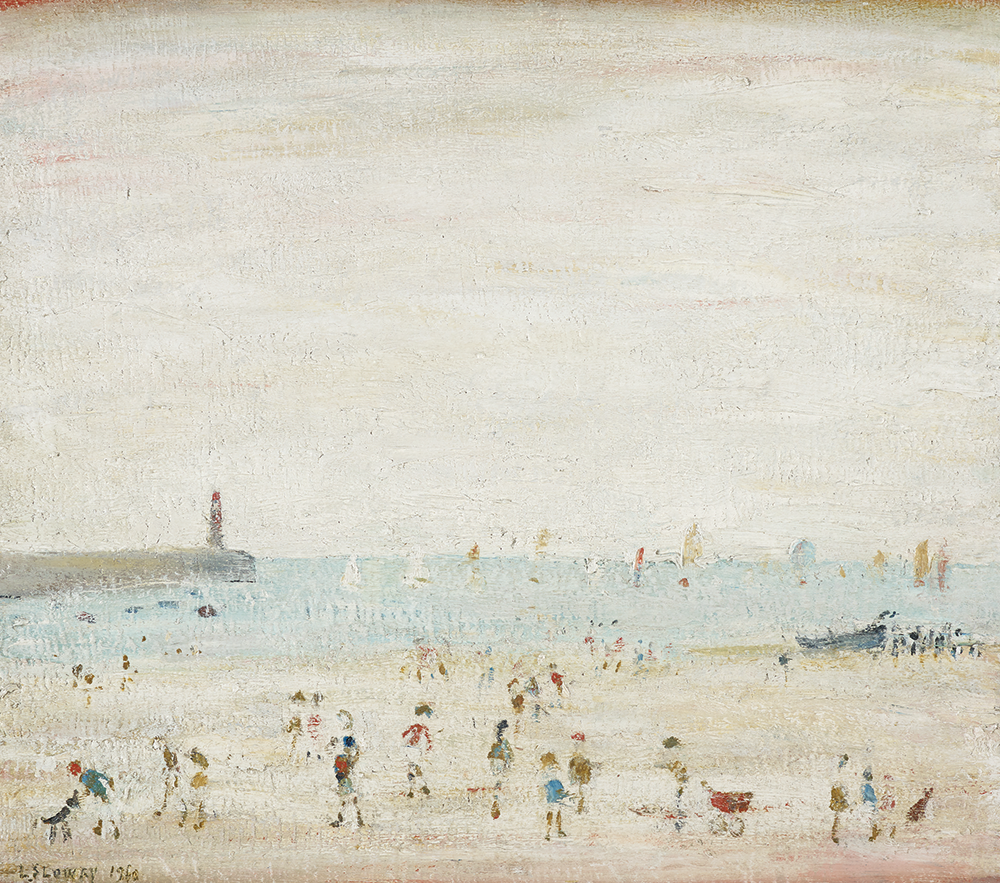In 1958 an elderly gentleman staying at the Castle Hotel in Berwick-upon-Tweed gave the receptionist a doodle he had made on the hotel’s notepaper. She kept it in a box and 43 years later, on the advice of Antiques Roadshow, sold it at auction for £8,000.
‘I don’t think anyone since Turner has looked at the sea with such an original eye’
A contemporary photograph shows that gentleman in his trademark trilby, dark suit and tie – no casual wear for L.S. Lowry – standing on the pier with Berwick in the background. Lowry (1887-1976) is not best known for his paintings of the sea, but there are 21 – including the receptionist’s sketch – in this interesting little exhibition in the Northumbrian town which he regular visited, and they cast him in an unaccustomed light.
Lowry discovered Berwick in the mid-1930s while on a holiday prescribed by his doctor as a cure for exhaustion, but his love of the sea went back to family holidays on the Lancashire coast and days out with his mother to Lytham St Annes. A painting of ‘Sailing Yachts at Lytham’ (late 1930s) was in fact the only picture for which his mother, who disapproved of the industrial scenes that made her son’s reputation, ever expressed admiration.
Her disapproval did not deflect him from his chosen path. Lowry’s decision to paint industrial subjects was a calculated one – ‘Nobody has done this,’ he thought, ‘I’ll have a shot at it’ – and so was the naive style adopted. The Salford rent-collector was not a self-taught outsider artist; he had failed to get into Manchester’s Municipal College of Art aged 18 but spent the next 23 years attending night classes, where one of his tutors was the young Adolphe Valette, newly arrived from France.
‘I cannot overestimate the effect on me at the time of the coming into this drab city of [Adolphe] Valette, full of the French impressionists, aware of everything that was going on in Paris,’ Lowry recalled years later. Valette specialised in painting water and silhouetted figures. The figures re-emerged in his pupil’s industrial landscapes in a cartoon form owing as much to silent comedy as to painting, but the water called for a painterly approach of which he proved himself more than capable.
In ‘July, the Seaside’ (1943), a compendium of beach activities – swings, sandcastles, puppet shows, donkey rides – on a single canvas, the familiar painter of matchstick men is at work, observing families at play like a traveller from another planet whose only previous knowledge of humanity was through slapstick comedy. Surely that fat man stretched on his back with his hat beside him is W.C. Fields? And the spindly figures in ‘On the Sands, Berwick’ (1959) look liable to blow away in a gust of wind like Buster Keaton’s Steamboat Bill
Jr. Lowry is as deadpan as Keaton, and as tragicomic – he claimed to have ‘no happy memories’ of his childhood.
The seascapes are a different kettle of fish. The early pastel ‘Yachts’ (1920), under the influence of Valette, is as atmospheric as a Degas sketch of the Normandy coast and more experimental, trapping the haze of a muggy English day in its tangled mass of opalescent strokes. In the later oil painting ‘Spittal Sands, Berwick’ (1960), distant forms are frayed by the impasto as if viewed through eyes screwed up against the glare (see below).

In the 1960s Lowry began to visit Sunderland – which he claimed to like ‘because nobody else did’ – and paint the tanker traffic from his room at the Seaburn Hotel, much as Monet painted the tugboats from his suite at the Savoy. His techniques became increasingly innovative: the paint surface of ‘Five Ships’ (1960s) has been scratched with a sharp implement to add dazzle to the ripples.
After the loss of his mother in 1939, Lowry’s relationship with the sea changed. The watershed was a visit to Anglesey in 1944 during which, he told the art historian John Rothenstein: ‘I was bored to death… I could hardly look at anything. A month after I got home, I started to paint the sea, nothing but the sea. But a sea with no shore and nobody sailing on it – only the sea. Look at my seascapes, they don’t really exist you know, they are just an expression of my own loneliness.’ They are also rather ominous: the great sluggish mass of oncoming grey-green waves in ‘The Sea’ (1963) looks ready to spill over the frame into the gallery. He often wondered what would happen if ‘the tide didn’t turn and the sea came on and on and on and on and on… Awful, isn’t it?’
A surreal ‘Self-portrait as a Pillar in the Sea’ (1966) illustrates Lowry’s belief, in disagreement with Donne, that ‘every human creature is an island’. From his personal island he viewed the sea through a unique lens. ‘I don’t think anyone since Turner has looked at the sea with such an original eye,’ said his dealer Andras Kalman. On the evidence of this exhibition, he was right.







Comments